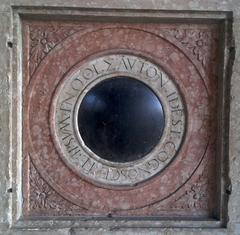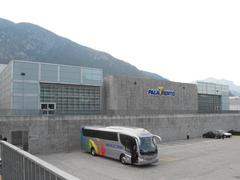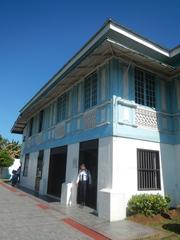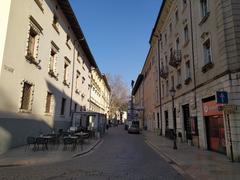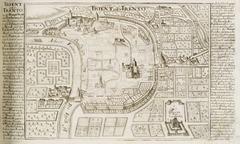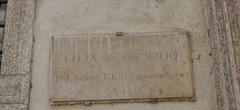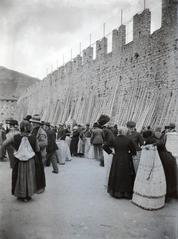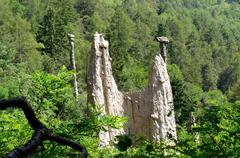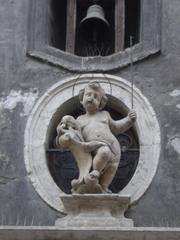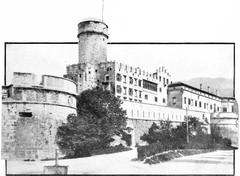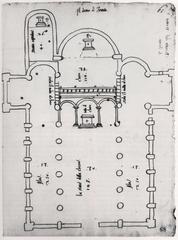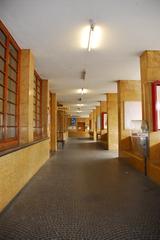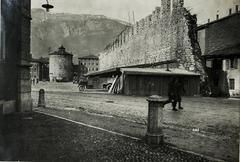Visiting Piazza Cesare Battisti in Trento: History, Tickets, and Tips
Date: 18/07/2024
Introduction
Piazza Cesare Battisti, situated in the historic heart of Trento, Italy, is a vibrant square steeped in history, culture, and architectural splendor. This bustling hub, often referred to by locals as Piazza Dante, has been a focal point of the city’s evolution from the medieval era to modern times. Named in honor of the irredentist martyr Cesare Battisti, the square serves as a testament to Trento’s resilience and ingenuity. Visitors to Piazza Cesare Battisti can immerse themselves in the rich tapestry of Trento’s past while enjoying its contemporary vibrancy, making it a must-visit destination for history buffs, cultural enthusiasts, and casual travelers alike. From its origins as a medieval marketplace to its transformation into a modern urban space, Piazza Cesare Battisti reflects the socio-political and architectural changes that have shaped Trento over the centuries (Exploring Piazza Cesare Battisti).
Table of Contents
- Introduction
- From Medieval Origins to a Modern Square
- The Dawn of a New Era - Demolition and Transformation
- The Birth of Piazza Cesare Battisti - A Symbol of Modernity
- Architectural Gems - A Fusion of Styles
- A Gathering Place for the Community
- Visitor Information
- The Significance of Piazza Cesare Battisti - A Reflection of Trento’s Identity
- A Legacy of Transformation and Renewal
- Main Attractions and Points of Interest
- Conclusion
From Medieval Origins to a Modern Square
The area now known as Piazza Cesare Battisti has been a focal point of Trento since the Middle Ages. Originally, this space was occupied by a dense network of medieval houses and narrow streets, typical of the period. This area, known as the “Contrada Larga,” served as a vital commercial artery, connecting the city center with the Adige River.
The Dawn of a New Era - Demolition and Transformation
The late 19th and early 20th centuries ushered in a period of significant urban renewal in Trento, and Piazza Cesare Battisti was not immune to these changes. The decision to demolish the old medieval structures to make way for a modern square was a significant one, reflecting a broader trend in urban planning at the time. This transformation aimed to create open, airy spaces that would improve sanitation, traffic flow, and the overall aesthetic appeal of the city.
The Birth of Piazza Cesare Battisti - A Symbol of Modernity
The demolition work, carried out between 1919 and 1926, marked a turning point in the history of the square. The newly created Piazza Cesare Battisti, named in honor of the irredentist martyr Cesare Battisti, emerged as a symbol of modernity and progress. The square’s design, characterized by its rectangular shape and elegant buildings, reflected the architectural trends of the time, drawing inspiration from the rationalist style gaining popularity in Italy.
Architectural Gems - A Fusion of Styles
The buildings surrounding Piazza Cesare Battisti stand as testaments to the architectural diversity that defines Trento. Among the most notable is the Palazzo della Regione, a striking example of Fascist-era architecture. Its imposing facade, adorned with intricate details and a commanding clock tower, reflects the architectural grandeur of the period.
A Gathering Place for the Community
Throughout its history, Piazza Cesare Battisti has served as a vital gathering place for the people of Trento. The square has hosted countless events, from lively markets and festivals to political rallies and cultural performances. This tradition continues today, with the piazza remaining a vibrant hub for social interaction and community life.
Visitor Information
Visiting Hours
Piazza Cesare Battisti is open to the public 24/7. However, specific attractions within the square, such as the Palazzo della Regione, may have their own visiting hours. It is advisable to check ahead for any schedule changes or special events.
Tickets
Access to Piazza Cesare Battisti is free. However, some surrounding attractions may require tickets. Please check the official websites of these attractions for the most up-to-date pricing and availability.
Travel Tips
- Transportation - Piazza Cesare Battisti is easily accessible by public transportation. Trento’s main bus and train stations are just a short walk away.
- Best Time to Visit - The square is particularly lively during weekends and public holidays. To experience local events and markets, consider visiting during these times.
- Nearby Attractions - Don’t miss other historical sites in Trento, such as the Trento Cathedral and the Castello del Buonconsiglio.
- Accessibility - The square is wheelchair accessible, with ramps and smooth pavements for easy navigation.
The Significance of Piazza Cesare Battisti - A Reflection of Trento’s Identity
Piazza Cesare Battisti holds a special place in the hearts of Trento’s residents. It is more than just a geographical space; it is a symbol of the city’s history, resilience, and evolving identity. The square’s transformation from a medieval quarter to a modern piazza reflects Trento’s journey through time, embracing progress while honoring its past.
A Legacy of Transformation and Renewal
The story of Piazza Cesare Battisti is a testament to the ever-changing nature of urban landscapes. Its history reminds us that cities are not static entities but rather dynamic spaces shaped by social, political, and cultural forces. As Trento continues to evolve, Piazza Cesare Battisti will undoubtedly remain a vital part of its urban fabric, a place where history and modernity converge.
Main Attractions and Points of Interest
The Monument to Dante Alighieri
Dominating the piazza is the imposing Monument to Dante Alighieri (Monument to Dante Alighieri). Erected in 1890, this grand monument pays homage to the famed Italian poet, Dante Alighieri. The monument’s central figure is a bronze statue of Dante, standing tall and proud. Surrounding him are allegorical figures representing different cantos of his epic poem, the Divine Comedy. The monument is not just a visual spectacle; it’s a symbol of Trento’s connection to Italian literature and history.
Palazzo della Regione
On the southern side of the piazza stands the Palazzo della Regione (Palazzo della Regione), a grand palace that speaks volumes about the city’s political past. This historic building, dating back to the 13th century, has served as the seat of power for various ruling entities throughout Trento’s history. Today, it houses the offices of the Autonomous Province of Trento. While the interior is primarily used for administrative purposes, the palace’s exterior, with its elegant Renaissance facade, is a sight to behold.
Case Cazuffi-Rella
Adding a touch of architectural elegance to the piazza are the Case Cazuffi-Rella (Case Cazuffi-Rella). These historic buildings, with their charming pastel-colored facades and intricate architectural details, offer a glimpse into Trento’s past. The buildings date back to the 16th century and represent a blend of Gothic and Renaissance styles. Today, they house shops, restaurants, and apartments, adding to the lively atmosphere of the piazza.
The Fountain of Neptune
While not as grand as the Dante monument, the Fountain of Neptune (Fountain of Neptune) holds its own charm. This 18th-century fountain, located at the piazza’s southern end, features a statue of Neptune, the Roman god of the sea, standing triumphantly atop a rocky base. The fountain is a testament to Trento’s historical significance as a crossroads of trade and culture.
The Social Theatre
On the western side of the piazza stands the Social Theatre (Social Theatre), a cultural hub that has been entertaining audiences since the 19th century. This neoclassical theatre, with its grand facade and ornate interiors, has hosted countless theatrical performances, concerts, and cultural events over the years. It stands as a testament to Trento’s vibrant arts and culture scene.
The Grand Hotel Trento
For those seeking a luxurious stay with a touch of history, the Grand Hotel Trento (Grand Hotel Trento), located on the piazza’s northern side, is an excellent choice. This historic hotel, dating back to the early 20th century, has hosted numerous dignitaries and celebrities over the years. Its elegant interiors, adorned with period furniture and artwork, offer a glimpse into Trento’s glamorous past.
The Surrounding Streets and Alleys
Beyond the main attractions, the streets and alleys branching out from Piazza Cesare Battisti are worth exploring. These charming passageways are lined with boutiques, artisan workshops, cafes, and restaurants, offering a taste of local life and culture.
Events and Festivities
Piazza Cesare Battisti is not just a place to visit; it’s a place to experience. Throughout the year, the piazza comes alive with various events and festivities. From the Christmas market, with its twinkling lights and festive cheer, to the Trento Film Festival, showcasing the best of mountain and adventure films, there’s always something happening in this vibrant square.
People-Watching and Soaking in the Atmosphere
One of the best ways to experience Piazza Cesare Battisti is simply to find a bench, relax, and watch the world go by. The piazza is a melting pot of locals and tourists, students and professionals, artists and families, all contributing to its unique and lively atmosphere.
Photographic Opportunities
With its stunning architecture, vibrant atmosphere, and picturesque surroundings, Piazza Cesare Battisti offers ample opportunities for photography enthusiasts. Whether you’re capturing the grandeur of the Dante monument, the elegance of the Palazzo della Regione, or the lively street scenes, you’re sure to find plenty of Instagram-worthy shots.
Conclusion
Piazza Cesare Battisti stands as a living monument to Trento’s rich and dynamic history, bridging the past and present in a unique and engaging way. Its transformation from a medieval quarter to a modern piazza symbolizes the city’s continuous evolution and adaptation to new cultural, social, and architectural trends. The square remains a vibrant hub for community gatherings, cultural events, and everyday social interactions, embodying the spirit of Trento’s residents. Whether exploring its historical landmarks, attending local festivals, or simply enjoying a leisurely stroll, visitors to Piazza Cesare Battisti can experience the essence of Trento’s identity and heritage. As Trento continues to grow and evolve, Piazza Cesare Battisti will undoubtedly remain a cornerstone of its urban fabric, celebrating both its historical legacy and its modern-day significance (Exploring Piazza Cesare Battisti, Visiting Piazza Cesare Battisti).
References
- Exploring Piazza Cesare Battisti - History, Significance, and Visitor Information in Trento, 2023, Author Exploring Piazza Cesare Battisti
- Exploring Piazza Cesare Battisti - Key Attractions and Visitor Information in Trento, 2023, Author Social Theatre
- Visiting Piazza Cesare Battisti - Tips, Tickets, and Attractions in Trento, 2023, Author Case Cazuffi-Rella
